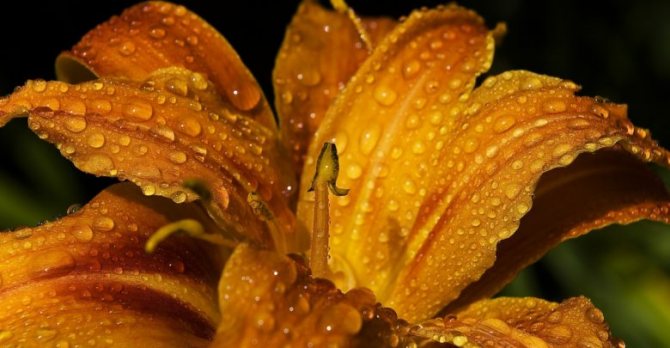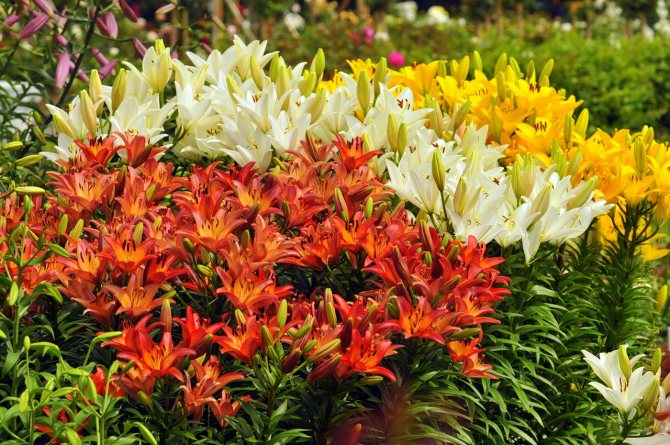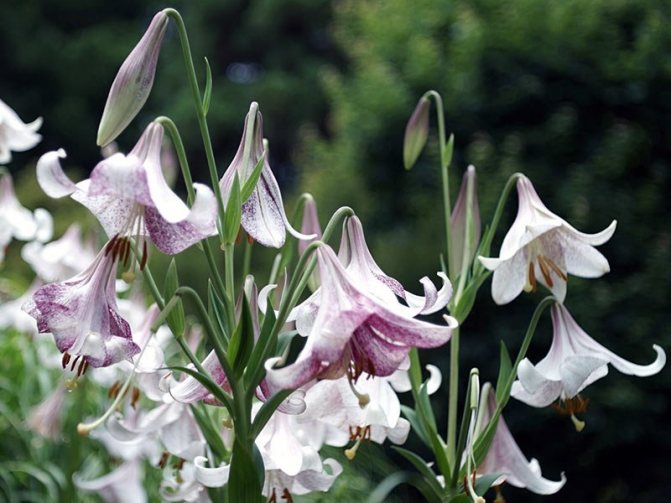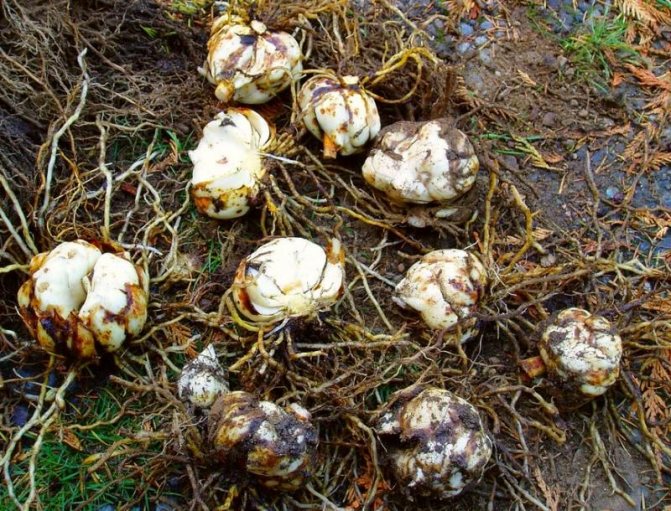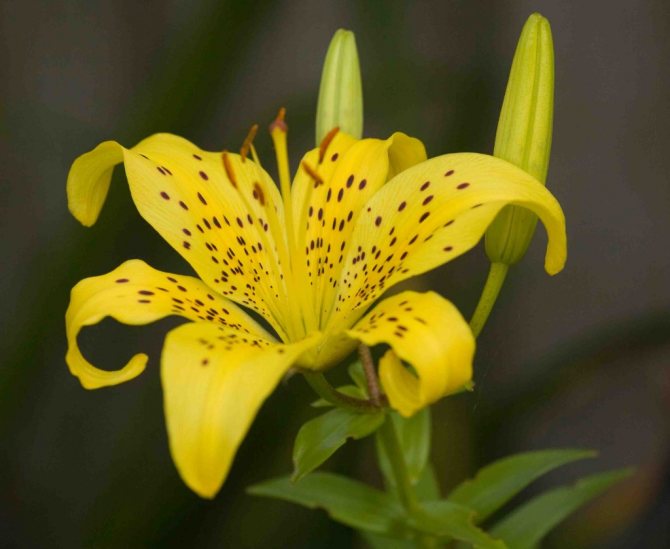In the maintenance and care of such exquisite and delicate flowers as lilies, every little detail is important, and especially for exotic plant varieties. It is necessary not only to choose the right place in the garden where the flowers will grow, but also to determine the optimal timing for planting or digging out the bulbs, as well as to carry out these procedures in accordance with the agrotechnical requirements of the culture. In our article, we will tell you how to correctly determine the planting time of lilies, when to dig up the bulbs, where to store them before planting, how often to transplant lilies, whether lilies can be transplanted in summer and how to care for lilies after transplanting.
When to transplant lilies
When can lilies be transplanted from one place to another? Autumn is considered the optimal period for moving culture to a new place. The specific period directly depends on regional characteristics and climate. In Central Russia, the procedure should be carried out in late August or early September. In the south, this can be done later - from mid-September to mid-October.
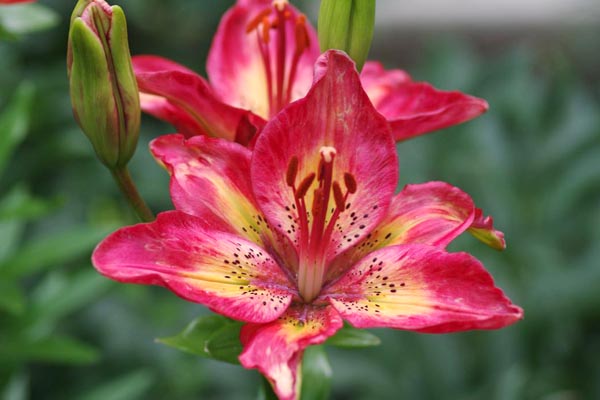
Lily is a beautiful decorative culture
Important! Regardless of the time, the transplant should be carried out only after flowering is complete. Otherwise, the bushes may die.
Why do you need a transplant and what will happen if you do not do it
2-3 years old lilies that grow in the open field bloom beautifully and are distinguished by rapid development. However, after the specified time has elapsed, the flowers become small, lose their decorative properties, and a slow development of shoots is observed. To avoid this, a lily transplant is carried out.
This procedure helps to avoid the following problems:
- cessation of flower growth;
- the appearance of sluggish and yellow leaves;
- rapid growth and elongation;
- fungi and bacterial pathologies.
For your information! There are garden hybrids that do not need to be repotted frequently. It is permissible not to move them to a new place for 10 years. However, they are not very popular with flower growers.
The dependence of the transplant time on the variety of lilies
When is the best time to transplant lilies? Specific terms depend not only on regional characteristics, but also on the type of culture. To do this, you need to get an idea of the life cycles of the purchased species.
So, in the Candidum variety, a dormant period begins at the end of summer. At this time, it is worth starting a transplant, as well as other bulbous crops. In the first half of September, early varieties should be moved to a new location. Tubular or oriental crops can be replanted in early October. It is also permissible to do this in the spring months.
Important! If the average daily temperature is 0 ° C, it will not be possible to plant lilies. This is associated with the risk of hypothermia of the bulbs, slowing down the development of roots, and a decrease in immunity to fungi and infections.
Early and Asian varieties can be relocated in spring. It is allowed to do this even at the initial stage of bud formation. Immediately after the procedure, the plants should be slightly shaded and watered well.
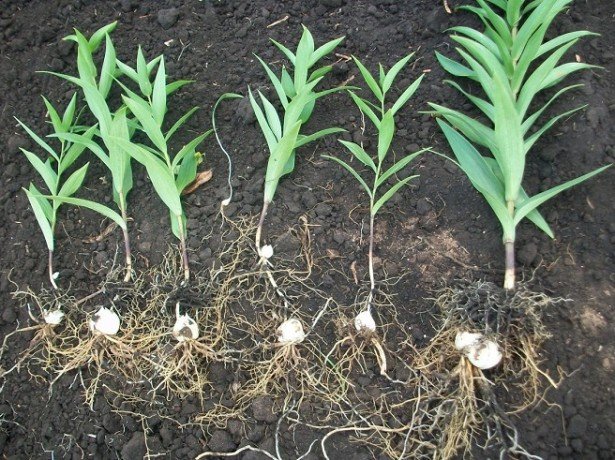

When growing a culture, it must be transplanted periodically.
Description
How to plant lilies at home correctly and painlessly for a plant is a question that worries many gardeners.This perennial flower can grow in one place for a long time, but when it begins to grow, it must be planted. If this is not done, the lily will become weak, it may start to hurt and even stop blooming. Dividing this beautiful plant is not a very difficult process, but you should know when and how to do it. To find out the answers to these questions, we suggest that you read this article.
When to plant lilies with a bulb in open ground: in autumn or spring
When to dig up lilies after flowering and when to plant them outdoors depends on the variety and gardener's preference. Everyone can choose the best option.
Planting in spring: pros and cons
Transplanting a rhododendron from one place to another
Most varieties should be replanted in the fall. However, some people do this work in the spring. The advantages of this method include the following:
- the ability to select the most viable bulbs that have wintered well in the refrigerator and do not have any flaws;
- no risk of freezing of the bulbs. This is especially important in regions with harsh winters. By storing the bulbs in the refrigerator or cellar, such problems can be avoided;
- the ability to easily adapt to new conditions. In the spring there are all conditions for the flowers to adapt well to the ground.
At the same time, the spring transplant also has certain disadvantages:
- problems with the development of the root system. In this case, the plant exists only at the expense of the bulb. In such a situation, the aboveground part is characterized by poor development, and flowering does not occur at all;
- lack of children. On bulbs transplanted in spring, babies do not form, so such plants cannot be propagated.
Transplant in the fall
Early plant species can bloom in late June or early July, middle ones bloom in late August. By the time of transplantation, they have time to rest and gain strength for the new season.
When to plant lilies? The best option for transplanting will be August or September. When carrying out the procedure at a later time, it is worth monitoring the weather conditions and temperature fluctuations.
With a later transplant, you need to take care of the covering material for the winter. This helps to avoid freezing of the bulbs. It should be borne in mind that this transplantation option can lead to a later ripening of peduncles in the next season.
Note! Late species, which bloom throughout September, are recommended to be left until spring. In mid-latitudes, late autumn transplanting is considered incorrect. In summer, only certain varieties are allowed to be replanted.


It is best to replant the culture in the fall.
Is it possible to transplant flowering lilies in summer
This event is considered quite dangerous and can cause serious harm to the culture. During the flowering period, only Asian varieties can be transplanted, which are distinguished by early blooming and are considered the most hardy.
For your information! During the flowering period, you can move to a new culture location Pearl Justin, Pink Haze, Montreux. This also applies to the varieties Lady Jane, Yeti, Red Velvet.
Why is autumn the best time to plant?
Experienced flower growers advise transplanting lilies in the fall. This option provides abundant flowering in the next season. In the fall, it is permissible not only to plant a culture, but also to reproduce it, which is possible due to the appearance of a large number of children.
With an autumn transplant, attention should be paid to warming the bulbs. In the north and northwest, it is recommended to do this earlier.
When to dig up lilies after flowering and when to plant
All gardeners should know the timing of digging and planting lilies in a new place. This is of great importance for the normal development of flowers, improving their appearance and condition.This is due to the fact that during the flowering period, the bulbs give off nutrients, decrease in size and lose weight.
How to feed lilies in autumn and spring before flowering
Recovery requires at least a month and a number of conditions are met:
- a large amount of soil over the bulb;
- the presence of many leaves;
- timely removal of seed bolls.
Note! With a shallow planting depth of bulbs after flowering, you need to top up fertile soil. Its thickness must be at least 15 cm.
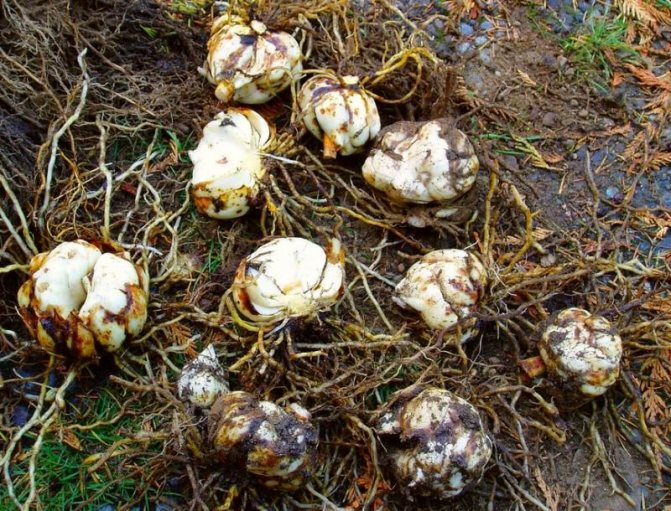

The bulbs need to be dug up on time
When to plant lilies after flowering
After the end of the flowering period, some time must pass before the transplant for the bulb to recover normally. This usually takes 4-6 weeks. It is important that the culture begins a period of dormancy.
The transplant can be carried out at the end of October. However, this is permissible only with late flowering, complete rest and restoration of the bulb.
To transplant a plant, you need to consider a number of recommendations:
- determine the landing time;
- take into account the quality of the planting material;
- choose the best place;
- provide the culture with proper care.
Useful tips for the gardener
To transplant and grow lilies, simple tips will help:
- late-flowering varieties are planted in spring;
- instead of a solution of potassium permanganate for disinfection, a solution of Fitosporin or another fungicide is suitable;
- flowers need watering from the second half of summer to late autumn;
- when sprouts appear, lilies are fed with nitrogen fertilizer;
- after flowering, lilies are fed with a potassium-phosphorus complex;
- in a rainy autumn, the planted lilies are covered with agrofibre, then they will better endure the winter;
- if the plants do not bloom for long and wither quickly, they need to be transplanted to a high bed;
- manure is not used to fertilize a flower garden, since it may contain pathogenic microorganisms.
All about lily transplant technology
How to transplant lilies? There are a number of features to consider.
How to properly transplant lilies to another place
After choosing the optimal time for the transplant, you can start this procedure. To do this, it is recommended to do the following:
- Cut off the stems near the very surface of the soil.
- Dig up the bulb carefully, taking care to avoid damaging the roots.
- Remove dead and dry scales from the bulb.
- Divide it gently into smaller bulbs.
- Hold the planting material in a weak solution of potassium permanganate or karbofos. This needs to be done for half an hour.
- Dig holes to the desired depth. It can be different, it all depends on the size of the roots.
- Pour a small amount of sand into the depression and plant the onion. Then sprinkle the plant with sand.
- Cover the top with soil and cover the bed with mulch. Sawdust or peat can play its role.
Digging the bulbs
Many people are interested in the question of when to dig up lilies for transplantation. This should be done very carefully at the moment when they are completely ready for this process and have accumulated the required amount of useful elements.
The bulbs should be carefully removed from the soil, carefully examined for diseases and damaged areas, and soaked in a weak solution of potassium permanganate. After that, separate the children and put them in the ground.
Storing bulbs for spring repotting
Bulbs for transplanting in spring should be kept in a cool room. The temperature should not be higher than 3 ° C. Planting material should be placed in a refrigerator or basement.
Planting material can be placed in a plastic bag filled with wet sawdust. It is important to make small holes in the bag to allow the bulbs to breathe. They need a separate compartment in the refrigerator.
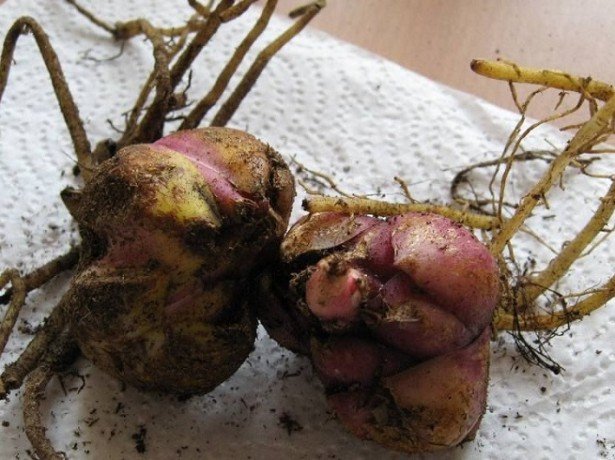

Bulbs need proper storage
The ways
You can plant bulbs in different ways:
- single line or tape.Between the lilies, you need to make a distance of 5-15 cm in one row and 50 cm between the rows;
- two-line suitable for medium lilies. A distance of 15-25 cm should be left between the bulbs. A gap of 25 cm should be made between the lines. The interval between adjacent ribbons should be 70 cm;
- the three-line applies to small lilies. An interval of 10-15 cm should be made between the bulbs.A gap of 25 cm can be made between the lines, and 70 cm between the ribbons.
Choosing a landing site
To achieve lush and abundant flowering, lilies should be planted in sunny and calm areas. If you plant the bushes in partial shade, they will bloom less brightly. If you plant lilies in the same place where they grew before, there is a risk of disease, so it is worth changing the topsoil.
Important! Flowers need a loose soil that allows air to pass through well. They will not grow where moisture is stagnant.
Preparing planting holes in a flower bed
Peat and sand should be present in the nutrient soil. As a mineral agent, it is worth adding potassium sulfate and superphosphate.
In case of high acidity, lime or wood ash must be used. At the same time, it is strictly forbidden to bring fresh manure into the ground. This will lead to the development of fungal infections.
Mulching and fertilizing bulbs
After the autumn transplant, when the soil slightly freezes, the lilies need to be insulated with a mulch layer. For this, spruce branches or dry foliage are used. With the onset of spring, the insulation must be removed.
For the first time, fertilizer should be applied over the snow before sprouts appear. At this stage, use any remedy for lilies. Similar fertilizers are suitable at the stage of bud formation. After the end of flowering, potassium and superphosphate are added.
Soil preparation
The soil for planting is dug to a depth of at least 40 cm, removing the roots of the weeds. For digging, make:
- peat;
- sand;
- superphosphate;
- potassium sulfate;
- soil deoxidizer (dolomite flour or wood ash).
For Asiatic lilies, which grow well in acidic soil, it is not necessary to reduce the acidity.
Note! Lilies cannot tolerate fresh manure, bird droppings and unripe compost. When these formulations are added, the risk of fungal infections and burns on the surface of the bulb increases.
Agrotechnical rules for caring for lilies after transplantation
Lilies are considered to be very unpretentious plants. During the flowering period, they need high-quality watering. In hot and dry weather, the crop should be watered abundantly. After flowering, the plant requires little or no water.
For the prevention of diseases, the bushes should be sprayed with Bordeaux liquid three times a year. At the first flowering, the buds are carefully removed. Thanks to this, the bush will be able to get stronger and bloom profusely.
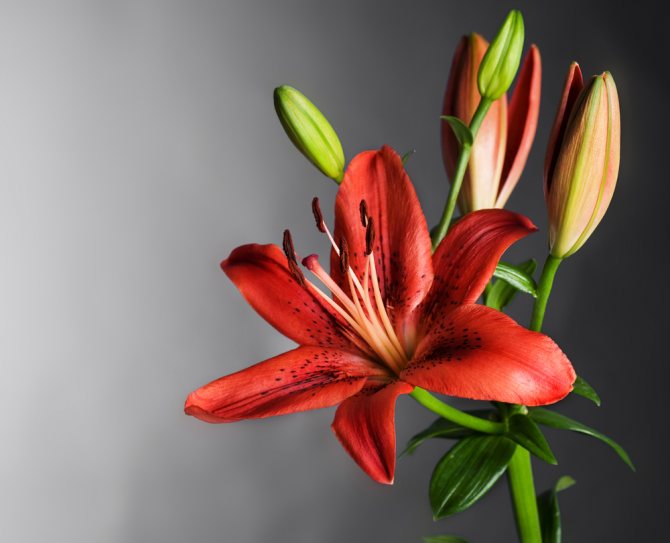

For lush flowering, lilies need to be properly cared for.
Lily transplant is a rather responsible process that requires adherence to certain recommendations. At the same time, you need to correctly choose the timing and adhere to the work technique.

